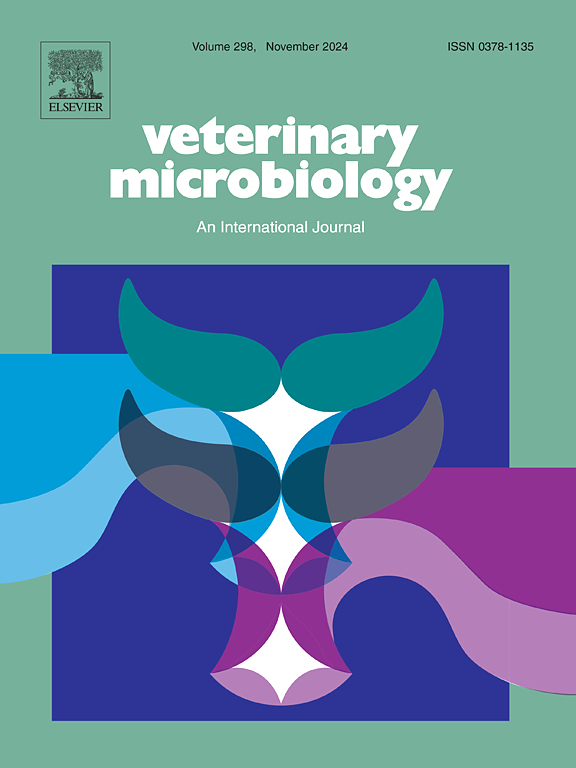8种重要家禽内源性逆转录病毒的多样性、进化和基因调控
IF 2.7
2区 农林科学
Q3 MICROBIOLOGY
引用次数: 0
摘要
内源性逆转录病毒(ERVs)是古代逆转录病毒感染的残余,它通过进化塑造了脊椎动物的基因组。在家禽中,尽管erv在基因组可塑性、基因调控和抗病方面具有潜在的作用,但它们的研究仍然不足。在这里,我们综合分析了来自3个科(鸭科、鸭科和鸭科)的8种家禽的erv,结合了从头挖掘、系统发育分类和功能表征。我们的研究揭示了ERV丰度的巨大差异,从46,326 (Cairina moschata)到79,018 (Meleagris gallopavo)每个基因组的元素数量不等。我们发现了23个不同的ERV群,包括20个新群,阿尔法逆转录病毒(10个群)占主导地位,表明谱系特异性扩增。一些erv与已知的家禽erv密切相关,表明它们有共同的进化起源,它们分布在不同的家族中,突出了谱系特异性的扩展模式,并表明它们可能在宿主基因组调控中发挥保守作用。值得注意的是,erv衍生序列对蛋白质编码(29.4-44.8 %)和长链非编码RNA(22.5-61.2 %)基因都有显著贡献,编码区明显缺失(CDS: 63.2-98.3 %),但调控区富集。我们进一步在关键发育基因(如CLC2DL4/5、TYR、CNTNAP2、CNTN5和LUZP2)中发现多态ERV插入,暗示其在转录后调控中发挥作用。然而,这些多态性插入在两个物种中特别观察到,Gallus Gallus(4个插入)和Numida meleagris(1个插入)。PCR基因分型证实,在鸡(n = 24)和鸭(n = 24)的小群体中存在活跃的ERV多态性,表明正在进行的基因组动态。这些发现强调了erv作为遗传创新和结构变异的双重媒介,对禽类基因组进化、宿主-病原体相互作用和家禽育种策略具有重要意义。本文章由计算机程序翻译,如有差异,请以英文原文为准。
Diversity, evolution, and gene regulation of endogenous retroviruses in eight important poultry species
Endogenous retroviruses (ERVs) are remnants of ancient retroviral infections that have shaped vertebrate genomes through evolution. In poultry, ERVs remain understudied despite their potential roles in genome plasticity, gene regulation, and disease resistance. Here, we presented a comprehensive analysis of ERVs across 8 poultry species from three families (Anatidae, Phasianidae, and Numidae), combining de novo mining, phylogenetic classification, and functional characterization. Our study revealed substantial variation in ERV abundance, ranging from 46,326 (Cairina moschata) to 79,018 (Meleagris gallopavo) elements per genome. We discovered 23 distinct ERV groups, including 20 novel groups, with dominance of Alpharetroviruses (10 groups), suggesting lineage-specific expansion. Several ERVs grouped closely with known poultry ERVs, indicating common evolutionary origins, they have been distributed across different families, highlighting lineage-specific expansion patterns and suggesting that they may play conserved roles in host genome regulation. Notably, ERV-derived sequences contribute significantly to both protein-coding (29.4–44.8 %) and long non-coding RNA (22.5–61.2 %) genes, with a pronounced depletion in coding regions (CDS: 63.2–98.3 %) but enrichment in regulatory regions. We further identified polymorphic ERV insertions in key developmental genes (e.g., CLC2DL4/5, TYR, CNTNAP2, CNTN5, and LUZP2), implying roles in post-transcriptional regulation. However, these polymorphic insertions were specifically observed in 2 species, Gallus gallus (4 insertions) and Numida meleagris (1 insertion). PCR genotyping confirmed active ERV polymorphisms in a small population of chickens (n = 24) and ducks (n = 24), indicating ongoing genomic dynamism. These findings underscore ERVs as dual agents of genetic innovation and structural variation, with implications for avian genome evolution, host-pathogen interactions, and poultry breeding strategies.
求助全文
通过发布文献求助,成功后即可免费获取论文全文。
去求助
来源期刊

Veterinary microbiology
农林科学-兽医学
CiteScore
5.90
自引率
6.10%
发文量
221
审稿时长
52 days
期刊介绍:
Veterinary Microbiology is concerned with microbial (bacterial, fungal, viral) diseases of domesticated vertebrate animals (livestock, companion animals, fur-bearing animals, game, poultry, fish) that supply food, other useful products or companionship. In addition, Microbial diseases of wild animals living in captivity, or as members of the feral fauna will also be considered if the infections are of interest because of their interrelation with humans (zoonoses) and/or domestic animals. Studies of antimicrobial resistance are also included, provided that the results represent a substantial advance in knowledge. Authors are strongly encouraged to read - prior to submission - the Editorials (''Scope or cope'' and ''Scope or cope II'') published previously in the journal. The Editors reserve the right to suggest submission to another journal for those papers which they feel would be more appropriate for consideration by that journal.
Original research papers of high quality and novelty on aspects of control, host response, molecular biology, pathogenesis, prevention, and treatment of microbial diseases of animals are published. Papers dealing primarily with immunology, epidemiology, molecular biology and antiviral or microbial agents will only be considered if they demonstrate a clear impact on a disease. Papers focusing solely on diagnostic techniques (such as another PCR protocol or ELISA) will not be published - focus should be on a microorganism and not on a particular technique. Papers only reporting microbial sequences, transcriptomics data, or proteomics data will not be considered unless the results represent a substantial advance in knowledge.
Drug trial papers will be considered if they have general application or significance. Papers on the identification of microorganisms will also be considered, but detailed taxonomic studies do not fall within the scope of the journal. Case reports will not be published, unless they have general application or contain novel aspects. Papers of geographically limited interest, which repeat what had been established elsewhere will not be considered. The readership of the journal is global.
 求助内容:
求助内容: 应助结果提醒方式:
应助结果提醒方式:


